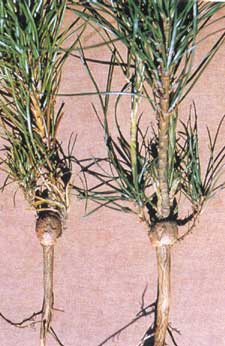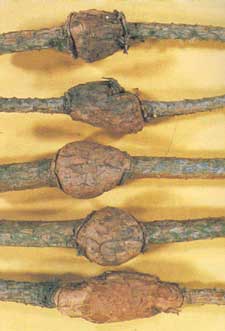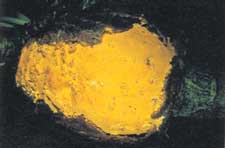Eastern and Western Gall RustsGlenn W. Peterson - Plant Pathologist (retired), Rocky Mountain Forest and Range Experiment Station, USDA Forest Service, Lincoln, NE, Cordell C.E., Anderson R.L., Hoffard W.H., Landis T.D., Smith R.S. Jr., Toko H.V., 1989. Forest Nursery Pests. USDA Forest Service, Agriculture Handbook No. 680, 184 pp. Hosts Eastern gall rust, caused by the fungus Cronartium quercuum, affects jack, Scotch, shortleaf, Virginia, and other hard pines. Primary alternate hosts, which are needed to complete its life cycle, are red and black oaks. Western gall rust, caused by the fungus Endocronartium harknessii (syn. Peridermium harknessii), affects many native hard pines, including ponderosa, lodgepole, jack, Monterey, Jeffrey, Coulter, knob-cone, bishop, and Digger pines. It also affects exotic Scotch, Swiss Mountain, Aleppo, and Canary Island pines. It needs no alternate host to complete its life cycle. Distribution Eastern gall rust occurs east of the Great Plains from Canada to the Gulf of Mexico. Western gall rust generally is found throughout the pine forests of the West, the northern Lake States, New England, New York, and Pennsylvania. Damage Although seedlings infected with eastern or western gall rust are not killed in the nursery, these seedlings are not salable and must be culled. Infected seedlings may die if outplanted, or the stem galls may weaken the main stem, eventually resulting in wind breakage or reduced wood quality. Infected nursery seedlings may also serve as foci for new infections in plantations. This is especially true with E. harknessii, which spreads from pine to pine. Diagnosis Look for globose to irregular galls on the stems of seedlings (fig. 5-1). Galls rarely are evident until the summer following the year of infection. Galls formed by the two fungi are similar in size and shape and cannot be distinguished on the basis of gall type. However, the presence of the characteristic hairlike telial state on oak leaves in the vicinity of the nursery suggests infection by eastern gall rust, which requires oaks to complete its life cycle. The absence of infected leaves on nearby oaks suggests western gall rust, which can spread from pine to pine.
Biology Aeciospores of C. quercuum form on galls and disperse from April to June. These spores infect oak leaves, but they do not infect pines. Basidiospores produced throughout the summer on infected oak leaves infect pine needles. The fungus grows from the pine needles into the stem, where it produces galls. Aeciospores of E. harknessii also form on galls and disperse from April to June. Unlike the spores of C. quercuum, however, which infect oaks, these spores directly infect current-year shoots of pines. Control Prevention - Remove all pines affected by western gall rust for a distance of one-half mile from the nursery. For eastern gall rust, remove oak hosts for a distance of one-half mile. Cultural - Adopt stringent culling practices to minimize the outplanting of infected seedlings. Selected References Anderson. G.W.; French. D.W. 1965. Differentiation of Cronartium quercuum and Cronartium coleosporiodes on the basis of aeciospore germ tubes. Phytopathology. 55: 171-173. Skilling. Darroll D. 1975. Jack pine rusts. In: Peterson, G.W.; Smith, Richard S., Jr., tech. coords. Forest nursery diseases, in the United States. Agric. Handb. 470. Washington. DC: U.S. Department of Agriculture: 59-61. Smith, Richard S., Jr. 1975. Western gall rust. In: Peterson. G.W.: Smith, Richard S., Jr., tech. coords. Forest nursery diseases in the United States. Agric. Handb. 470. Washington. DC: U.S. Department of Agriculture: 56-58. |
Forest Pests: Insects, Diseases & Other Damage Agents |

|
|




